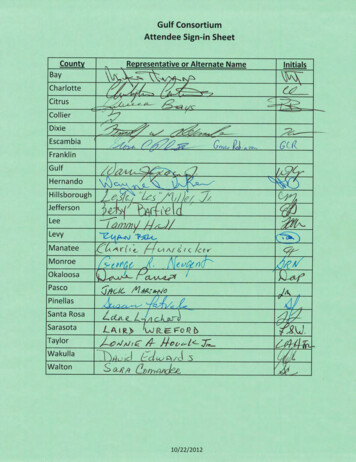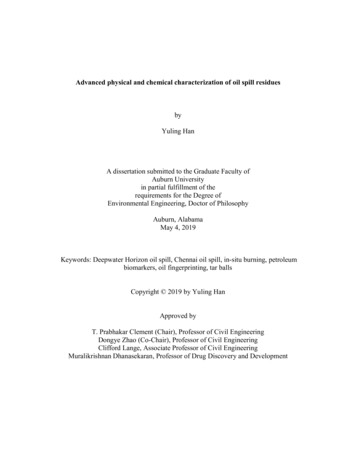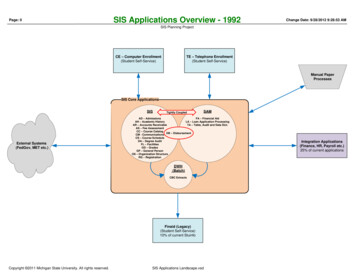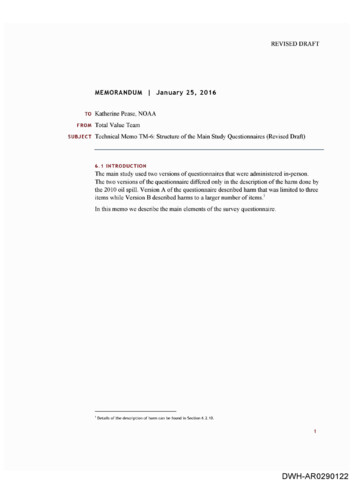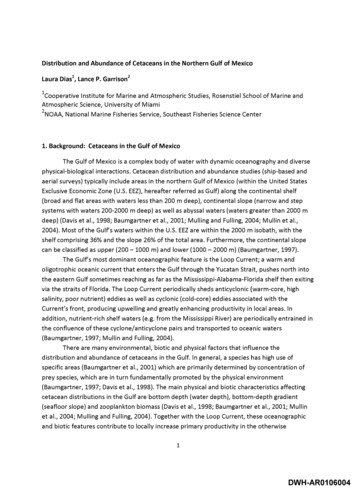
Transcription
Distribution and Abundance of Cetaceans in the Northern Gulf of MexicoLaura DiasS Lance P. Garrison Cooperative Institute fo r M arine and Atm ospheric Studies, Rosenstiel School o f M arine andAtm ospheric Science, University o f M iam i2NOAA, National M arine Fisheries Service, Southeast Fisheries Science Center1. Background: Cetaceans in the Gulf of MexicoThe Gulf o f Mexico is a com plex body o f w a ter w ith dynamic oceanography and diversephysical-biological interactions. Cetacean d istrib utio n and abundance studies (ship-based andaerial surveys) typically include areas in the northern Gulf o f Mexico (w ithin the United StatesExclusive Economic Zone (U.S. EEZ), hereafter referred as Gulf) along the continental shelf(broad and fla t areas w ith waters less than 200 m deep), continental slope (narrow and stepsystems w ith waters 200-2000 m deep) as well as abyssal waters (waters greater than 2000 mdeep) (Davis et al., 1998; Baum gartner et al., 2001; M ulling and Fulling, 2004; M ullin et al.,2004). M ost o f the G u lfs waters w ith in the U.S. EEZ are w ith in the 2000 m isobath, w ith theshelf comprising 36% and the slope 26% o f the to ta l area. Furtherm ore, the continental slopecan be classified as upper (200 - 1000 m) and low er (1000 - 2000 m) (Baumgartner, 1997).The G u lfs most dom inant oceanographic feature is the Loop Current; a warm andoligotrophic oceanic current th a t enters the Gulf through the Yucatan Strait, pushes north intothe eastern Gulf sometimes reaching as far as the Mississippi-Alabama-Florida shelf then exitingvia the straits o f Florida. The Loop Current periodically sheds anticyclonic (warm -core, highsalinity, poor nutrient) eddies as well as cyclonic (cold-core) eddies associated w ith theC urrent's fro n t, producing upw elling and greatly enhancing p roductivity in local areas. Inaddition, nutrient-rich shelf waters (e.g. fro m the Mississippi River) are periodically entrained inthe confluence o f these cyclone/anticyclone pairs and transported to oceanic waters(Baum gartner, 1997; M ullin and Fulling, 2004).There are many environm ental, biotic and physical factors th a t influence thed istrib u tio n and abundance o f cetaceans in the Gulf. In general, a species has high use ofspecific areas (Baum gartner et al., 2001) which are prim arily determ ined by concentration o fprey species, which are in tu rn fundam entally prom oted by the physical environm ent(Baum gartner, 1997; Davis et al., 1998). The main physical and biotic characteristics affectingcetacean distributions in the Gulf are b o tto m depth (w ater depth), b otto m -d ep th gradient(seafloor slope) and zooplankton biomass (Davis et al., 1998; Baumgartner et al., 2001; M ullinet al., 2004; M ulling and Fulling, 2004). Together w ith the Loop Current, these oceanographicand biotic features co ntribute to locally increase prim ary p roductivity in the otherwiseDWH-AR0106004
oligotrophic waters o f the Gulf (Baumgartner, 1997; M ullin and Fulling, 2004). In this summary,published and unpublished data sources were reviewed to characterize the d istrib utio n andabundance o f cetaceans in the northern Gulf o f Mexico (Table 1). In addition, analyses o f them ost recent o f the NMFS SEFSC ship surveys resulted in G ulf-wide estim ates o f cetaceandensity.Table 1. Sources o f data summarized in this review.ParameterSourceDistributionBaum gartner, M ., 1997. The distribution o f Risso's dolphin (G ram pus griseus) w ithpatternsrespect to th e physiography of th e northern Gulf o f Mexico. M a rin e M am m al Science,13 (4 ):6 1 4 -6 3 8 .Davis e t al., 1998. Physical h abitat of cetaceans along th e continental slope in th e northcentral and w estern Gulf o f Mexico. M arin e M am m al Science, 1 4 (3 ):4 9 0 -5 0 7 .Baum gartner e t al., 2001. Cetacean habitats in th e northern Gulf of Mexico.Fish.Bull.99:219-239M aze-Foley and M ullin, 2006. Cetaceans of th e oceanic northern Gulf o f Mexico:Distributions, group sizes and interspecific associations. J. Cetacean Res. M anage.8 (2 ):2 0 3 -2 1 3 .SEFSC unpublished data (m arine m am m al sightings data from 2007, 2008, 2009, 2010,2011, 2012 and 2014).Cetacean sightings data from NRDA aerial surveys(2010 and 2 0 1 1 -2 0 1 2 ) and vessels u rveys(2010)W aring e t al., 2009. US Atlantic and Gulf o f Mexico M a rin e M a m m a l Stock Assessments2009. NOAATechnical M em orand u m NMFS-NE-213.Jochens e t al., 2008. Sperm w h ale seismic study in th e Gulf of M exico. Synthesis report.U.S. D epartm en t o f th e Interior. M inerals M an ag em en t Service.AbundanceFulling e t al., 2003. Abundance and distribution o f cetaceans in o u te r continental shelfandw aters o f th e U.S. Gulf o f Mexico. Fish. Bull. 1 0 1:923-932.distributionpatternsM ullin and Fulling, 2004. Abundance o f cetaceans in th e oceanic northern Gulf ofMexico, 1 9 9 6 -2 0 0 1 . M a rin e M am m al Science, 20 (4 ):7 8 7 -8 0 7 .M ullin e t al., 2004. Abundance and seasonal occurrence o f cetaceans in th e outercontinental shelf and slope w aters of th e north-central and northw estern Gulf ofMexico. Gulf of M exico Science, 2 0 0 4 (1), pp.6 2-73.M ullin, 2007. Abundance of cetaceans in th e oceanic northern Gulf o f Mexico from2003 and 2004 ship surveys. SEFSC.DensityHildebrand e t al., 2012. Passive acoustic m onitoring of cetaceans in th e northern Gulf ofestim atesM exico during 2 0 1 0 -2 0 1 1 . Progress rep o rt fo r research ag reem en t # 2 0 1 0 5 1 3 8 .SEFSC unpublished data (2003, 2004, 2009)DWH-AR0106004-0002
2. Gulf of Mexico CetaceansA diverse com m unity o f tropical and subtropical cetacean species occupies waters o f thenorthern Gulf o f Mexico reflecting the complex physical oceanographic environm ent o f the Gulf(W aring et al., 2009, Table 2).Table 2. Cetacean species inhabiting the northern Gulf o f Mexico.Common name/speciesSpecific nameAreaA tlantic spotted dolphinStenella fro n ta lisGulfBlainville's beaked whaleMesoplodon densirostrisOceanic GulfCommon bottlenose dolphinTursiops truncatusShelf and OceanicGulfBryde's whaleBalaenoptera edeniOceanic GulfClymene dolphinStenella clymeneOceanic GulfCuvier's beaked whaleZiphius cavirostrisOceanic GulfD w arf sperm whaleKogia simaOceanic GulfFalse killer whalePseudorca crassidensOceanic GulfFraser's dolphinLagenodelphis hoseiOceanic GulfGervais' beaked whaleMesoplodon europaeusOceanic GulfKiller whaleOrcinus orcaOceanic GulfM elon-headed whalePeponocephala electroOceanic GulfPantropical spotted dolphinStenella attenuataOceanic GulfPygmy killer whaleFeresa attenuataOceanic GulfPygmy sperm whaleKogia brevicepsOceanic GulfRisso's dolphinGrampus griseusOceanic GulfShelf and OceanicShelf and OceanicRough-toothed dolphinSteno bredanensisGulfShort-finned pilot whaleGlobicephala macrorhynchusOceanic GulfSperm whalePhyseter macrocephalusOceanic GulfSpinner dolphinStenella longirostrisOceanic GulfStriped dolphinStenella coeruleoalbaOceanic GulfShip- and aerial-based cetacean surveys in the continental shelf, slope and oceanicw aters o f the Gulf usually detect between 17 and 19 species o f cetaceans (M ullin and Fulling,2004; M ullin et al., 2004; Maze-Foley and M ullin, 2006; M ullin, 2007; SEFSC unpublished data,1992-2014; Table 3). Species th a t are not easily identified at sea are usually categorizedaccording to fam ily (e.g., unidentified Ziphiid fo r beaked whales including Mesoplodon speciesand Cuvier's beaked whales) or genus (e.g., Kogia sp. fo r pygmy and d w a rf sperm whales andDWH-AR0106004-0003
Stenella sp. fo r Stellinid dolphins, among others) (SEFSC unpublished data, 1992-2014, Table 3).In addition, unidentified cetaceans, which prim arily include unidentified dolphins th a t are seenat a distance and hence cannot be reliably identified, constitute a considerable percentage o fsightings during d istrib utio n and abundance surveys (between 10% and 14% o f all cetaceansightings, as detected in M ullin et al., 2004; M ullin and Fulling, 2004 and M u llin 2007) andco ntribu te to negatively bias abundance estimates per species (M ullin and Fulling, 2004).Cryptic species, such as beaked whales and the pygmy and d w a rf sperm whales, also tend tohave negatively biased abundance estimates. Their cryptic behavior renders detection at sead iffic u lt and whenever detected it is d ifficu lt to visually identify the individual to species.During aerial and ship-based cetacean surveys, the most com m only sighted species inthe Gulf are bottlenose dolphins, pantropical spotted dolphins, A tlantic spotted dolphins,Risso's dolphins, sperm whales, and d w a rf and pygmy sperm whales (Kogia spp.; Baumgartneret al., 2001; M ullin and Fulling, 2004; M ullin et al., 2004, Maze-Foley and M ullin, 2006; M ullin,2007; SEFSC unpublished data. Table 3). Short-finned pilot whales, striped dolphins, Clymenedolphins, spinner dolphins and beaked whales (including Mesoplodon spp. and unidentifiedziphiids) are som ewhat com m only observed during surveys and have d iffe re n t rates ofdetection (M ullin et al., 2004; M ullin and Fulling, 2004; SEFSC unpublished data. Table 3). Rarelyrecorded species include melon-headed whales, false killer whales, killer whales and pygmykiller whales. Bryde's whales are also in fre qu e ntly seen and are the only species o f baleenwhale (m ysticete) recurrently seen in the Gulf (Baum gartner et al., 2001; M ullin and Fulling,2004; M ullin et al., 2004, Maze-Foley and M ullin, 2006 and M ullin, 2007; SEFSC unpublisheddata. Table 3). Fraser's dolphins are extrem ely rare and, although present in the Gulf, detectionrates are very low (M ullin and Fulling, 2004; SEFSC unpublished data. Table 3).DWH-AR0106004-0004
Table 3: Cetacean sightings recorded between 1992 and 2014 during SEFSC aerial and ship-based Total/spRate ofencounterCom mon bottlenose d olphin48531164043Pantropical sp otte d dolphin4263975657U nld. Dolphin26461023544Sperm w hale1920342415A tla n tic sp otte d d olphin713802123Risso's dolphin2415503119910143112P ygm y/D w arf sperm w hale352311162115920265U nld. O dontocete16141037544148Stenella sp.15612225146Spinner dolphin65126826167Striped dolphin71115337651010U nld. ZIphlld2583213117C lym ene dolphin61198287111R ough-toothed dolphin544344613S hort-flnned p ilo t w hale332244U nld. Small w hale32553U nld. M esoplodont65652U nld. Large w hale16721Bryde's w hale1211Cuvier's beaked w le's beaked w hale1134113913314761932Fraser's dolphin16853M e lo n -headed/P ygm y kille r w ha 402211Balaenoptera 11133Pygmy kille r whale78132Killer whale82621172302452941654911302171False k ille r whale8253228724553531423202851461813167794M elon-headed w 7115131131658926826842217282Rarest31U nld. Baleen w hale270Rare233Gervais' beaked w ha leSom ew hat com m on391U nld. M am m alTotal72111M ost com m 0005
4. Cetacean distributionCetacean species are sighted th ro u g h o u t the Gulf, w idely distributed along thecontinental shelf, shelf break and slope waters (M ulling and Fulling, 2004; M ullin et al., 2004).Even a fte r compensating fo r unequal e ffo rt, spatial distributions o f sightings indicate th a td iffe re n t species may be selecting habitats according to specific oceanographic features(Baum gartner et al., 2001). In addition, species may overlap in range but fin e r scale partitioningprobably allows sympatric species to share the ecosystem and avoid or m inim ize com petition(Baum gartner et al., 2001; Maze-Foley and M ullin, 2006). Bottom depth and b otto m depthgradient are some o f the main features influencing cetacean d istrib utio n (Davis et al., 1998)(Table 4).Table 4: Cetacean d istribution in the G ulf in relation to b otto m depth. References used toconstruct this table: Davis et al., 1998, Maze-Foley and M ullin, 2006, SEFSC unpublished data(1992-2014). * Group found in the steepest depth-gradient (Davis et al., 1998). Mean bottomdepth excludes sightings in w a ter depths less than 100m. Main areas o f occurrence are basedupon visual inspection and summary o f sightings maps.SpeciesMean bottomdepth (m)Atlantic197spottedHabitatMain areas of occurrenceM ostly shelf (b etw een coast and 200Overall uniform distributionm isobath).in d eep er w aters over th edolphinCom moncontinental shelf.293Estuarine and coastal (estuarineOverall uniform distribution;bottlenosew aters and coastal w aters b etw eenslight concentration on th edolphincoast and 20 m isobath, not includedshelf break at th e MSRD andin this rep o rt), shelf (b etw een 2 0 - 200th e shelf b re a k /u p p e r slopem isobath) and upper slope (b etw eeno ff FL Panhandle2 0 0 - 1000 m isobaths).Rough 950M ostly slope (b etw een 200 m andto o th e d1500 m isobaths) and some sightingsdolphinon th e Texas shelf.Bryde's226whalesRisso'sShelf along th e 200 m isobath o ff th eOverall uniform distributionDe Soto Canyonw est coast o f Florida.714d o lp hin *U pper slope (b etw een th e 200 m andOverall uniform distribution,1000 m isobaths)m ainly concentrated at MSU pper slope (b etw een 500 m andW e s t of th e Mississippi River1000 m isobaths).DeltaU pper slope (b etw een th e 200 m andEast o f th e Mississippi RiverCanyon and FL EscarpmentShort-finned863pilot whaleSpinner1111d o lp hin *1000 m isobaths)Delta (S o f M o b ile Bay) alongth e FL EscarpmentStripedd o lp hin *1235Lower slope ( 1000 m) and abyssalOverall uniform distribution;slight concentration S ofM o b ile BayDWH-AR0106004-0006
Sperm w h a le *1000Slope (along th e 1000 m isobath) andOverall uniform distributionabyssalw ith concentrated areas offth e MS Canyon and FLEscarpment (Dry Tortugas)P ygm y/D w arf928sperm w haleSlope (b e tw e e n th e 200 m and 2000Overall uniform distribution;m isobaths)slightly focused tow ards(Kogia spp.)Pantropicalcentral-eastern Gulf1242Slope, abyssal ( 1000 m)Overall uniform distribution;spottedslightly concentrated SdolphinM o b ile Bay and along th e FLEscarpmentBeaked-1 2 0 0whalesSlope (b etw een 1000 m and 2000 mOverall uniform distribution;isobath) and abyssal ( 2000 m) w atersconcentration along th e FL(M esoplodonEscarpmentspp.,Unid. Ziphiid)Clymene1260Slope and abyssal ( 1000 m)dolphinOverall uniform distributionto w ards th e w est o f th eMississippi River Delta andcentral abyssal w atersFalse killer1301Slope and abyssal ( 200 m)w haleOverall uniform distribution;slightly concentratedtow ards central-eastern Gulf(o ff FL Escarpment)M e lo n 1401headed w haleFraser's1483Slope (b e tw e e n th e 1000 m and 2000Central Gulf and w est of th em isobaths).Mississippi River DeltaAbyssal (?)Uniform distribution,dolphinh ow ever sightings areextrem ely rareKiller w hale1866Slope and abyssal ( 1500 m)Central Gulf o ff th ePygmy killer2406Slope and abyssalOverall uniform distribution;Mississippi River Deltaw haleslightly tow ards central-eastLine transect surveys have been conducted since the early 1990s by the Southeast FisheriesScience Center. During 1992-2001, these surveys were "piggy-backed" on plankton surveysth a t follow ed fixed tracklines each year, prim arily during the late spring. From 2003 onward,dedicated marine mammal vessel surveys were conducted during sum m er months. Theresulting surveys provide a com prehensive overview o f cetacean d istrib utio n in the northernG ulf o f Mexico (Figure 1).DWH-AR0106004-0007
Survey efrorl during ship-based operations between 1992 - 2001n c ju S o n— 1994993WCONTOURUG u lfof M exico \—-2000—-1000—-2 0 0'Lfj?025 50100-2S'[T[rN?! r a il s ‘ tMexicoB a200s i n150nlfib u to N a u tic a l M i!e s ,-vSurvey effort during ship-based operations betw een 20 03 - 2 0 0 9 DW HHou stonus EEZG u T J f M e. x T c oFloridaMexi coBasi nMauticalcMniHavanartie, 'jt B t sFigure 1. Vessel surveys conducted by the SFESC between 1992 - 2009. Sightings maps belowinclude additional survey data fro m 2010-2014 th a t are not shown in these figures.DWH-AR0106004-0008
4.1 Shelf speciesThree species are norm ally recorded in the shallow shelf waters o f the Gulf: Atlanticspotted dolphins, bottlenose dolphins and to a lesser degree, rough-toothed dolphins. A tlanticspotted dolphins occur mainly over the continental shelf, and sightings are usually associatedw ith the shallowest b ottom depths and b otto m depth gradients when compared to o thercetacean species (Davis et al., 1998; Figure 2). However some opportunistic sightings indicateth a t this species occupy deeper w aters (up to 500 m), especially on the northeastern part o fthe Gulf, south o f the Florida Panhandle on the west Florida Escarpment (Fulling et al., 2003).A tlantic spotted dolphin sightings during ship-based and aerial surveys, 1992-2014.o t M e XI c o 9 f' D W H siteIs o b a th-20-200-1000US E E ZMexicoBasinNautical Miles25 50Esrl, D e L o rn , G EBC O . MOAA M G D ii n d o t J ie tn b . u td t r c e s '200Figure 2: Sightings d istrib utio n o f A tlantic spotted dolphins, SEFSC unpublished data, 1992-2014Rough-toothed dolphins are broadly distributed in the oceanic waters, at various depthsbut usually in deep waters o f the Gulf (Davis et al., 1998; Maze-Foley and M ullin, 2006). Thedetection o f a fe w rough-toothed dolphins in waters less than 200 m deep mainly o ff the Texascoast is an interesting finding since this species is usually described as inhabiting oceanic waters(Fulling et al., 2003) (Figure 3).DWH-AR0106004-0009
Rough-toothed dolphin sightings during ship-based and aerial surveys, 1992-2014.33ffO"N D W H siteIsobath-20-200-10002000MexicoBasinUS EEZNautical Mites25.t5C200Esri, D e L o rm e . E B C ’E, y O A A H G O C , eii3 o lh e f.s-ource.W . felhei gtijtf;Ma1ional Gegg[faphieilPeLortne,G eprg yi S jyg.-anBA A .H aFigure 3: Sightings d istrib utio n o f rough-toothed dolphins, SEFSC unpublished data, 1992-2014Common bottlenose dolphins are recorded throu g ho u t the continental shelf and shelfbreak waters o f the Gulf (Figure 4). C urrently tw o genetically distinct ecotypes o f commonbottlenose dolphins are recognized: 1- coastal, inhabiting inshore waters (bays, sounds andestuaries) as well as fro m the shoreline to the 20 m isobath and continental shelf and, 2offshore, which occurs mainly along the 200 m isobath and in deeper waters o f the Gulf(V ollm er 2011).10DWH-AR0106004-0010
Common bottlenose dolphin sightings during ship-based and aerial surveys, 1992-2014.O r 1? n dTampa*D W H siteIs o b a thMexi coBasi nu s EEZSiauttcal Mfles20 4080120Lorme160kN l5 rii Ehe!Esriii BCO, A AFigure 4: Sightings d istrib utio n o f com m on bottlenose dolphins, SEFSC unpublished data, 19922014The common bottlenose dolphin is the only species th a t is curre n tly divided intom ultiple stocks in the Gulf. In to ta l, 37 stocks are currently delim ited in the northern Gulf foundacross fo u r m ajor habitat types: 1- oceanic, 2- shelf, 3- coastal and 4- bay, sound and estuary(BSE). The Oceanic Stock is found th ro u g h o u t the Gulf in waters deeper than 200m, consistingo f the offshore ecotype. The Continental Shelf Stock is distributed G ulf-wide in waters between20m and 200m deep, probably consisting o f a m ixture o f both the coastal and offshoreecotypes. The coastal and BSE stocks are delineated in coastal waters between the shorelineand the 20 m isobath and in estuarine waters (W aring et al., 2009) and w ill not be addressed inthis part o f the report.4.2 Baleen whalesBryde's whales are the only m ysticete species known to regularly inhabit G ulf o f Mexicowaters. Their d istrib utio n is restricted to the northeast region o f the Gulf, between the 180 and360m isobaths in the De Soto Canyon region (M ullin and Fulling, 2004; Maze-Foley and M ullin,2006) (Figure 5).11DWH-AR0106004-0011
Baleen whales sightings during ship-based and aerial surveys, 1992-2012. B alaenoptera sp. B ryde's w h aleD W H siteUS EEZ-200 -1000kNautical Miles50.E i, DeLqrme, G E .O rH d .N (jD C , antJ a.t ?r.contribwtore, .Sources:'Esri. GEBCO, NOaV,120Figure 5: Sightings d istrib utio n o f Bryde's whales, SEFSC unpublished data, 1992-201212DWH-AR0106004-0012
4.3 Oceanic SpeciesShort-finned pilot whales and Risso's dolphins inhabit areas o f the upper continentalslope o f the Gulf. Short-finned p ilo t whales are prim arily located west o f the Mississippi RiverDelta, between 500 m and 2000 m w ater-depths (Maze-Foley and M ullin, 2006) (Figure 6).Short-finned pilot w hale sightings during ship-based and aerial surveys, 1992-2014.O tia r dTam par jautical MilesFloridaKe\D W H siteIs o b a th200-1000MexicoBasinH a v a ru2000US EEZDeLorm e, G EBCO,iN.OAA-fiGDC a n V .o th e rjs n b u to rs , Sources: Esg, tSEBCO, N AA,N alionai Geoaraohtc. D e L i e . HERE.'and oth e r contributors*Figure 6: Sightings d istrib utio n o f short-finned p ilo t whales, SEFSC unpublished data, 1992-2014Risso's dolphins are deep w a ter species, usually found in narrow core habitats betweenthe 350 m and 975 m isobaths where steep w a ter depth-gradients are present (Baumgartner,1997) (Figure 7). In addition, Baumgartner (1997) identified tw o core habitats fo r Risso'sdolphin in the Gulf: 1- Mississippi River Delta and, 2- along the Florida Escarpment o ff the westcoast o f Florida. Sighting rates w ith in these regions are five and six tim es higher than theaverage rates fo r ship- and aerial-based surveys, respectively (Baumgartner, 1997).13DWH-AR0106004-0013
Risso's dolphin sightings during ship-based and aerial surveys, 1992-2014.TandoTam paNauticalF/orfdaKeysD W H siteIs o b a th2001000-2000US EEZMexicoBasinADeLor«neancti'oliie'r. AilE EEsn. S e b a a ,and othe r eontributofsFigure 7: Sightings d istrib utio n o f Risso's dolphins, SEFSC unpublished data, 1992-2014Similarly to Risso's dolphins, spinner and striped dolphins tend to occur in waters w iththe steepest bottom -depth gradients (Davis et al., 1998). Spinner dolphins prim arily occur easto f the Mississippi River Delta along the Florida Escarpment. Striped dolphins are also prim arilyobserved in the eastern Gulf, but have a w ider d istribution pattern and occupy deeper waterso f the Gulf (Maze-Foley and M ullin, 2006)(Figure 8).14DWH-AR0106004-0014
Spinner and Striped dolphins sightings during ship-based and aerial surveys, 1992-2014.S pinner dolphin Striped dolphin9 f D W H site200-10002000Nautical MilesUS EEZ15306090120Esrj, DeLorme.'GE'SG.Q. NOASltNGDCSancfdntfibucors .Sources:. .tMational G eographic, Q e \s 'rrrie .\jE R 'G e a 3 a n te s q g i-ana o th e r'c o n tfib t fsM9AA-,Figure 8: Sightings d istrib utio n o f spinner and striped dolphins, SEFSC unpublished data, 19922014Sperm whales are w idely distributed in the oceanic waters o f the Gulf, usually along anddeeper than the 1000 m isobath (Figure 9). Two regions show high rates o f encounters: 1Mississippi Canyon just seaward o f the Mississippi River Delta and 2- Florida Escarpmentbetween Tampa and Key W est (including the Dry Tortugas area) (Baum gartner et al., 2001;M ullin and Fulling, 2004; Maze-Foley and M ullin, 2006). Satellite tagging o f whales along the1000 m isobath, between Mississippi and De Soto canyons showed no discernable seasonalm igrations and a high degree o f site -fid elity and year-round usage o f the Gulf, prim arily byfem ales (Jochens et al., 2008). In addition, tracking o f m ovem ents o f im m ature males had greatvariability, which suggested th a t males have larger individual home ranges and used deeperw aters than females (rarely docum ented in waters deeper than 2000 m). Furtherm ore, malestended to occur in deeper waters than females, exhibiting a significant difference o f nearly 300m between the median b otto m depth o f 1171 m fo r males and 884 m fo r fem ales (thus femalesare fre qu e ntly located at the upper slope, but also at areas o f increased depth-gradients)(Jochens et al., 2008).15DWH-AR0106004-0015
Sperm whale sightings during ship-based and aerial surveys, 1992-2014.O nan dfTam pa D W H site londaKeysIs o b a th200MexicoBasin1000-2000US EEZNautical Miles20 4080120160DeLormeational G eographicoiieTH R eohars, Sources. Esri, G EBC O , NOAAothe r e c n trjbu ]prgFigure 9: Sightings d istrib utio n o f sperm whales, SEFSC unpublished data, 1992-2014Dwarf and pygmy sperm whales (Kogia spp.) are w idely distributed in the oceanicwaters o f the Gulf (Maze-Foley and M ullin, 2006) (Figure 10). However, an analysis o f th e iroccurrence in relationship to physical and biological features found th a t sightings rates are 2.5tim es in the upper continental slope compared to the G ulf-wide average. This increaseddensity was associated w ith increased zooplankton biomass (Baum gartner et al., 2001).16DWH-AR0106004-0016
pygmy and Dwarft sperm whales sightings during ship-based and aerial surveys, 1992-2014.#D W H siteIs o b a th-200-1000-2000u s EEZNauRcal M iles.0 15 306090andcontrib . Sgur es. JsrT: GEBCQ. N O AflD el-orme. TCR4 "( eo ra F T s.g ! g,. o o H ie r g ri@ p r120Figure 10: Sightings d istrib utio n o f pygmy and d w a rf sperm whales, SEFSC unpublished data,1992-2014Pantropical spotted dolphins are the most common and abundant species in the oceanicGulf; they are w idely distributed in waters deeper than 1000 m (Maze-Foley and M ullin, 2006)(Figure 11). Baumgartner et al., (2001) found that, even though w idely distributed along theslope and abyssal waters o f the Gulf, pantropical spotted dolphins reach a maximum sightingrate just east o f the Mississippi River Delta and south o f M obile Bay, AL. In addition, eventhough no significant correlation was found between the high use o f these tw o areas andenvironm ental characteristics analyzed during the study, depth may influence the d istributiono f this species in the oceanic waters o f the Gulf (Baum gartner et al., 2001).17DWH-AR0106004-0017
Pantropical spotted dolphin sightings during ship-based and aerial surveys, 1992-2014.O ria n JTBmOeNauticalFiorida D W H siteis o b a th2001000MexicoBasin2000H avanaUS EEZDeLorme,a n c t N ig n tr ib ijto r s , Sources; fe ri.G E B C S ), NOAAH E 5' G eoi1% ijres.org. and othe r eonlfibutors jFigure 11: Sightings d istrib utio n o f pantropical spotted dolphins, SEFSC unpublished data, 19922014O ther deep w a ter cetaceans include beaked whales (Mesoplodon sp. and unidentifiedziphiids), which show an overall uniform d istrib utio n in slope waters deeper than 1000 m (Daviset al., 1998; Maze-Foley and M ullin, 2006) (Figure 12). Like Kogia species, beaked whales arehighly cryptic and d ifficu lt to identify at sea, the re fo re most sightings are usually classified asunidentified ziphiids or Mesoplodon sp.18DWH-AR0106004-0018
Beaked whales sightings during ship-based and aerial surveys, 1992-2014.Tam paoM eI c o Blam vilie s be ak e d w hale C uvier's beak e d w h aieF/Of idsOG e rv a is ’ be ak e d w haleKey I Unid. M esoplo dontUnid. Ziphiid:tco* J t D W H siteUS EEZ20010002000D eL orireNGDCDeLorffie .HtRE, GeonSeurces; Esri. GEB'CjO, N O A A .bothe r contributorsINautical0 20 4080120160Figure 12: Sightings d istrib utio n o f beaked whales, SEFSC unpublished data, 1992-2014Clymene dolphins are m ostly distributed in the deep waters o f western G ulf (Davis et al.,1998; Maze-Foley and M ullin, 2006). Fraser's dolphins show varied d istrib utio n in the deep Gulf(Maze-Foley and M ullin, 2006) but since sightings are so rare it is d ifficu lt to establish a mainarea o f occurrence (Figure 13).19DWH-AR0106004-0019
Clymene and Fraser's dolphins sightings during ship-based surveys*, 1992-2014.C ly m en e dolphinFraser's dolphinD W H site20010002000US E E ZEsrj, DeLor, a n d ’S th e re o n tn b r s . S ottrcesi E i . GE.BCO, NOorrn THE' E, G e a n a e so r p d b th ' n liiB iito rs Nautical Miles0 153090eoco"w *No aenal survey sightings120Figure 13: Sightings d istrib utio n o f Clymene and Fraser's dolphins, SEFSC unpublished data,1992-2014M elon-headed whales, false killer whales, and pygmy killer whales are rarely observedduring cetacean surveys. W ith the data th a t are available, melon-headed whales inhabit thew estern waters o f the Gulf along the 1000 m isobath while false killer and pygmy killer whalesoccur prim arily in the deep waters o f the eastern G ulf (Maze-Foley and M ullin, 2006) (Figure14).20DWH-AR0106004-0020
Blackfish* sightings during ship-based and aeriai surveys, 1992-2014.- bNF alse killer w haleM e lo n -h e ad ed / P ygm y killer w h ale M e lo n -h e ad ed w h alePygm y killer w h ale D W H site-2001000Lcrpne. GEBCO, NOAAD eLoim e-2000US EEZ Except pilotwtialesthefiC ontfiputore.IS Q tircea EsnfGEBC ); NOGedn3}Ties‘’5 ! a n o \j l'r i; T } sow wNautical Miles0 20 4080120160Figure 14: Sightings d istrib utio n o f blackfish (m elon-headed, false killer and pygmy killerwhales), SEFSC unpublished data, 1992-2014Sightings records o f killer whales are extrem ely rare. When observed, killer whales occurprim arily west o f the Mississippi River Delta in waters deeper than 700 m (Maze-Foley andM ullin, 2006) (Figure 15).Killer w hale sightings during ship-based surveys’ , 1992-2010. D W H siteIs o b a th20010002000US EEZGuI!of [0XIroNo aerial survey sightingsNautical Mi es0204080120160E » i, DeLofrine,Soujcfe&:,;E i, GEBG.O, NOAAN a tio n a lo V b d r a p h iQ e L - e . H E fiE , O T a l § i-d ra .;b n d ‘ ithej edrilfibulttir.s.Figure 15: Sightings d istrib utio n o f killer whales, SEFSC unpublished data, 1992-201021DWH-AR0106004-0021
5. Cetacean abundance5.1 Published abundance estimatesPantropical spotted dolphins are the most com m only sighted and ab
Laura DiasS Lance P. Garrison Cooperative Institute for Marine and Atmospheric Studies, Rosenstiel School of Marine and . Science Center 1. Background: Cetaceans in the Gulf of Mexico The Gulf of Mexico is a complex body of water with dynamic oceanography and diverse physical-biological interactions. Cetacean distribution and abundance .


